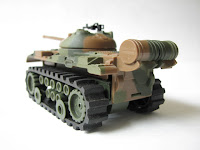 Often as a project draws to a close my interest wanes and I slow down. This was not the case with this project. I sprinted over the finish line on this one. After completing all the components, I was very excited to assemble the final piece.
Often as a project draws to a close my interest wanes and I slow down. This was not the case with this project. I sprinted over the finish line on this one. After completing all the components, I was very excited to assemble the final piece. Before assembly began I had to put a finish on the scabbard (saya). Sayas are traditionally finished in a variety of ways. Lacquer is one of the more common finishes. I decided to go with modern automotive enamels instead of a traditional lacquer finish. I made this decision for a couple reasons. Firstly, traditional lacquer is a process that I am not familiar with-- and I knew I could replicate the look of a lacquer finish with enamels. Secondly, lacquer is quite toxic-- I did use clear lacquer on the metal fittings but it is becoming increasingly hard to find lacquer here in California. The finish on the saya is a combination of four different enamels layered to give the look of lacquer with gold powder embedded in it. I also applied several coats of clear top coat.
The final assembly mostly involves lacing the hilt (tsuka) with a silk cord material called ito. I managed to hunt down instructions on how to lace a tsuka online. These are the best instructions out there. Silk ito comes in a variety of colors. I settled on a color called tetsu which is the Japanese word for iron. The color is a very dark gunmetal blue. I also ordered some tetsu ito in a wider size to use as the lanyard for the saya-- also known as a sageo. The sageo was tied in a fancy knot known as the ronin knot. Now please enjoy a some pictures of the finished project:





Thanks for following this project with me. I am quite satisfied with the results however there are things I learned, and things I would do differently. In the end it was a rewarding study of traditional Japanese sword making techniques.
Thanks for looking.






Thanks for following this project with me. I am quite satisfied with the results however there are things I learned, and things I would do differently. In the end it was a rewarding study of traditional Japanese sword making techniques.
Thanks for looking.






 I decided to fabricate the fittings from metals that I could easily form and solder. I chose brass and copper. Copper can be easily softened through heat treatment (annealing), as I mentioned in
I decided to fabricate the fittings from metals that I could easily form and solder. I chose brass and copper. Copper can be easily softened through heat treatment (annealing), as I mentioned in 













 armies received reinforcements in the way that only the raw power a double "A" battery could provide. Despite our generally peaceful household, our ex-hippie parents temporarily cast aside their ideals and bought my brother and I battery-powered Stomper tanks. Soon these motorized marvels became one of our favorite toys. We would test the tanks' terrain tackling prowess by running them through a barrage of backyard obstacles. Puddles, rocks, dirt, sticks-- there was a true sense of achievement when your tank came through unscathed.
armies received reinforcements in the way that only the raw power a double "A" battery could provide. Despite our generally peaceful household, our ex-hippie parents temporarily cast aside their ideals and bought my brother and I battery-powered Stomper tanks. Soon these motorized marvels became one of our favorite toys. We would test the tanks' terrain tackling prowess by running them through a barrage of backyard obstacles. Puddles, rocks, dirt, sticks-- there was a true sense of achievement when your tank came through unscathed.




 In the movie Alien we are introduced to Gigers vision when the crew of a commercial space towing vehicle makes an unscheduled detour to a planet that is emitting a repeating radio signal. They discover the wreck of an alien craft on the surface of the planet. The vessel is long forgotten-- and in a dramatic scene, we discover a long deceased space traveler who fell victim to his own deadly cargo. The giant being appears to be fossilized and growing out of his biomechanoid chair. In a foreboding clue of what will happen to his human discoverers, he has a hole in his chest where the bones appear to be exploded outwards.
In the movie Alien we are introduced to Gigers vision when the crew of a commercial space towing vehicle makes an unscheduled detour to a planet that is emitting a repeating radio signal. They discover the wreck of an alien craft on the surface of the planet. The vessel is long forgotten-- and in a dramatic scene, we discover a long deceased space traveler who fell victim to his own deadly cargo. The giant being appears to be fossilized and growing out of his biomechanoid chair. In a foreboding clue of what will happen to his human discoverers, he has a hole in his chest where the bones appear to be exploded outwards.
